Wildflowers, Grasses and Other Nonwoody Plants
Media

Species Types
Scientific Name
Dioscorea oppositifolia (sometimes called D. batatas)
Description
Similar to kudzu, Chinese yam is an aggressive vine that overtakes nearly everything within reach that stands still long enough! Learn more about this invasive plant — and please don’t plant it!
Media
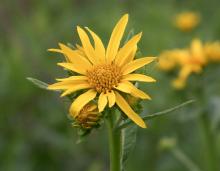
Species Types
Scientific Name
Verbesina helianthoides
Description
Yellow crownbeard and its close relatives are called wingstems because of lengthwise, winged ridges along the stems. Look for it blooming, May through October, in open and rocky areas.
Media
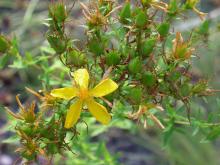
Species Types
Scientific Name
Hypericum perforatum
Description
In Europe, St. John’s-wort was long used as a medicinal herb and to ward off evil magic. Today, researchers are finding it can treat depression. Yet it poisons livestock and in some places is an invasive weed.
Media

Species Types
Scientific Name
Najas spp.
Description
Naiads are slender, narrow-leaved plants that grow completely under water and are rooted to the bottom. They never have broad, floating leaves or conspicuous flowers or seed heads.
Media
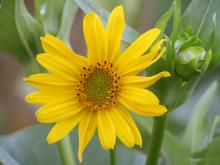
Species Types
Scientific Name
Silphium perfoliatum
Description
Called carpenter’s weed for its remarkably square stems, cup plant is also notable for its large, opposite leaves that fuse around the stem to form a leafy cup that holds rainwater.
Media
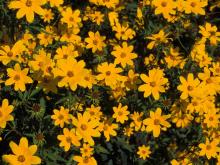
Species Types
Scientific Name
Bidens aristosa
Description
Tickseed sunflower has flattened black seeds that attach themselves to clothing and pets via two needlelike awns. In flower, it grows in massive displays in moist bottomlands.
Media

Species Types
Scientific Name
Heliopsis helianthoides
Description
Ox-eye is a sunflower lookalike. This member of the sunflower family is not a true Helianthus, but a Heliopsis. This attractive perennial is growing in popularity as a native garden flower.
Media

Species Types
Scientific Name
Helianthus tuberosus
Description
Jerusalem artichoke deserves a better common name. This tall native sunflower has edible tubers and great crop potential, but it has never been very big commercially. Fortunately, we can enjoy it for free in nature.
Media
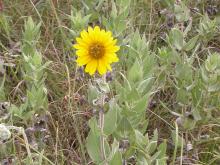
Species Types
Scientific Name
Helianthus mollis
Description
Ashy sunflower is relatively short compared to others in its genus. Its leaves are grayish, hairy, sessile, and broadly oval. Its colonies are common in upland prairies in the southern half of the state.
Media
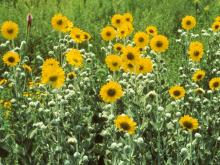
Species Types
Scientific Name
Helianthus spp.
Description
Most people recognize sunflowers when they see them, with their bright yellow ray flowers and rather flattened center of dark disk flowers. There are 16 species of Helianthus in Missouri.
See Also
About Wildflowers, Grasses and Other Nonwoody Plants in Missouri
A very simple way of thinking about the green world is to divide the vascular plants into two groups: woody and nonwoody (or herbaceous). But this is an artificial division; many plant families include some species that are woody and some that are not. The diversity of nonwoody vascular plants is staggering! Think of all the ferns, grasses, sedges, lilies, peas, sunflowers, nightshades, milkweeds, mustards, mints, and mallows — weeds and wildflowers — and many more!





















